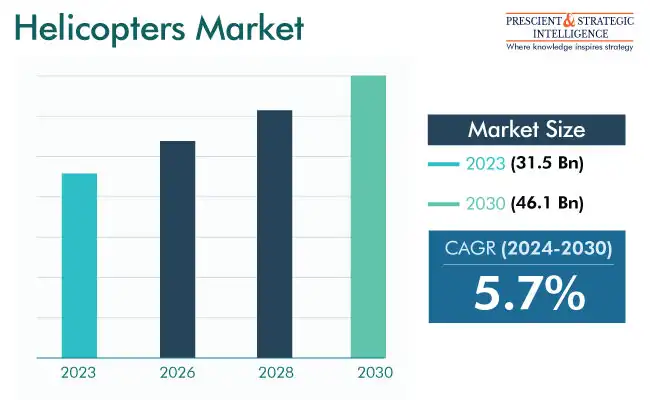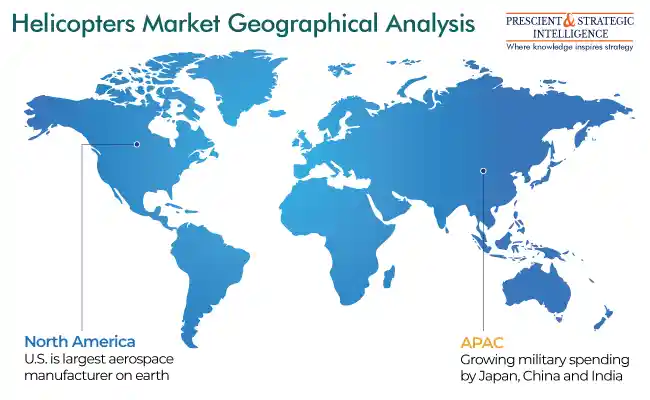Report Code: 10692 | Available Format: PDF
Helicopters Market Revenue Forecast Report: Size, Share, Recent Trends, Strategic Developments, Segmentation Analysis, and Evolving Opportunities, 2024-2030
- Report Code: 10692
- Available Format: PDF
- Report Description
- Table of Contents
- Request Free Sample
Market Overview
The helicopters market size has been estimated at USD 31.5 billion in 2023, and it will grow at a rate of 5.7% during 2024–2030, to reach USD 46.1 billion by 2030.
The weaker impact of helicopters on the environment than full-fledged aircraft is a key market driver. Moreover, larger cabin sizes, longer flying ranges, performance technology upgrades, and brand experience are all driving the success of new models. In the coming years, the trend of using helicopters for emergency medical services will generate additional growth opportunities.

Helicopters are deployed for air ambulance services as they can reach remote areas faster than conventional automobiles and even traditional aircraft. They can be used to reach distant, inaccessible places, such as a military base deep in the forest or an oil rig in the middle of the sea, within a short period.
The early medical treatment of patients enabled by a quick emergency transport via helicopters enhances the survival rate in serious cases. For instance, MH-60 Jayhawks stationed at USCG Station Kodiak play a key role in fishing operations in the remote and treacherous Bering Sea by lifting crewmembers in distress off boats and transporting them to the nearest healthcare center in Dutch Harbor.
Big Data, AI, and Electric and Hybrid Propulsion Systems Are Key Trends
Developments in the world of technology and products are major trends in this industry as well. Key aerospace & defense firms are striving to develop electric and hybrid drives, incorporate artificial intelligence, and transition toward unmanned operations and thus, create even more-efficient and dependable helicopters.
For example, Avio Aero, which is a GE Aerospace company that designs and manufactures civil and military aircraft subsystems, exhibited its VRT500 single-engine light rotorcraft at the Dubai Air Show in 2019. This format integrates the gas turbine and electric motor in one unit, to take over for a disabled/damaged engine when landing the vehicle.
Upgrades are also being undertaken to bring greater safety, efficiency, and performance in unmanned systems as well as increase the capabilities of avionics sensors. Moreover, big data and analysis are increasingly becoming essential in this industry, with operators now applying data to optimize maintenance schedules, minimize safety risks, and reduce costs.
Growing Adoption in Military & Defense To Boost Market
The expanding helicopter utilization in the military and defense world and the new transportation needs arising from modern forms of warfare, which demands more-flexible transportation services, will all drive the industry growth. Rotary-wing aircraft are useful tools because they can be employed for transportation and logistics as well as combat or reconnaissance operations in all kinds of war conditions.
Key functions of helicopters in the military include in troop transport to forward bases (often in offshore and high-altitude areas), search and rescue, cargo transport, and medevac, in addition to direct combat. This versatility has made them an invaluable asset for militaries around the world, with countries adding a variety of helicopters to their arsenal.
Increasing Need for Air Ambulance Services Is Major Driver
An air ambulance transports the ill or injured to a hospital in an emergency. Helicopters can be modified in response to the need for rapid transportation for critical patients. Helicopter air ambulances are currently one of the fastest means available today, after aircraft, but the latter cannot land or take-off from everywhere.
Medical technology developments have led to the increasing use of air ambulance services throughout the world as they offer convenient transport for seriously ill people. Because of the accessibility to otherwise unattainable regions, they remain ideal for carrying patients directly into medical centers.
The mounting aging population and increasing incidence of chronic diseases with sudden flare-ups contribute to a strong need for air ambulance services. This increasing demand will stimulate the development of the industry as helicopters are prized for their quickness and flexibility of landing and take-off.
| Report Attribute | Details |
Market Size in 2023 |
USD 31.5 Billion |
Revenue Forecast in 2030 |
USD 46.1 Billion |
Growth Rate |
5.7% CAGR |
Historical Years |
2017-2023 |
Forecast Years |
2024-2030 |
Report Scope |
Market Trends, Drivers, and Restraints; Revenue Estimation and Forecast; Segmentation Analysis; Impact of COVID-19; Companies’ Strategic Developments; Market Share Analysis of Key Players; Company Profiling |
Explore more about this report - Request free sample
Civil Category Holds Significant Share
The civil category, based on type, holds a significant share. This is a result of the growing demand for emergency air transportation services and an ever-growing reliance on air travel. With the growing population and expanding cities, requests for fast transport are increasing at a high rate.
These changing requirements have made helicopters highly popular for their ability to work in all kinds of terrain. This has underlined their use in search and rescue operations, medical evacuation attempts, and even point-to-point deliveries.
Emergency Medical Services (EMS) Are Significant Application
The emergency medical services category, on the basis of application, is a key revenue contributor, attributed to the increasing number of people suffering from a sudden worsening of their health. Helicopters can offer life support so that medical personnel and equipment can reach the scene of emergency or patients can be swiftly taken to a healthcare center.
Light Category Is Key Revenue Contributor
The light category, based on weight, is a large contributor to the industry in 2023. These craft have a weight limit under 6,000 pounds, which makes them capable of speedy take-offs, extended maneuvering, and prompt landings. Their dominance is because of the growing demand in both the civil and commercial sectors for air photography missions, sightseeing flights, and helping small groups of passengers travel with luggage.
North America Is Market Leader
North America dominates the industry in 2023. The most-important reason for this dominance is that the world's leading manufacturers are based in this continent, including Bell, Sikorsky, and Boeing. They produce many types of helicopters for all military and civil applications, to which they continue to bring technological advancements.
Vast urban areas and scenic sites are suitable locations for helicopters’ commercial use, such as transportation and tourism, while the sea presents opportunities for offshore operations. North America also has the largest military sector in the world, with helicopters of all weight classes and with all kinds of modifications being used.

APAC is likely to advance at the fastest rate in the years to come. India and China are among the world’s biggest military spenders, and they continue to incorporate helicopters in all facets of their armed forces. Additionally, due to the perpetual security concerns, high-ranking government officials and rich businesspersons often use helicopters for transportation. In the same way, Pawan Hans Limited offers air transportation services to civilians in India via helicopters.
Key Companies in Helicopters Market
- Airbus SE
- Leonardo S.p.A.
- Textron Inc.
- The Boeing Company
- ROBINSON HELICOPTER COMPANY INC.
- Hindustan Aeronautics Ltd.
- Kawasaki Heavy Industries Ltd.
- Kaman Corporation
- Lockheed Martin Corporation
- Bell Aircraft Corporation
- Russian Helicopters
- Airbus S.E.
Want a report tailored exactly to your business strategy?
Request CustomizationWant an insight-rich discussion with the report author?
Speak to AnalystOur dedication to providing the most-accurate market information has earned us verification by Dun & Bradstreet (D&B). We strive for quality checking of the highest level to enable data-driven decision making for you
Our insights into the minutest levels of the markets, including the latest trends and competitive landscape, give you all the answers you need to take your business to new heights
With 24/7 research support, we ensure that the wheels of your business never stop turning. Don’t let time stand in your way. Get all your queries answered with a simple phone call or email, as and when required
We take a cautious approach to protecting your personal and confidential information. Trust is the strongest bond that connects us and our clients, and trust we build by complying with all international and domestic data protection and privacy laws